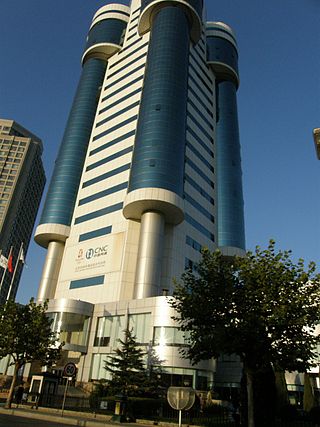India's telecommunication network is the second largest in the world by number of telephone users with 1179.49 million subscribers as on 31 January 2021. It has one of the lowest call tariffs in the world enabled by mega telecom operators and hyper-competition among them. India has the world's second-largest Internet user-base with 747.41 million broadband internet subscribers in the country.
The People's Republic of China possesses a diversified communications system that links all parts of the country by Internet, telephone, telegraph, radio, and television. The country is served by an extensive system of automatic telephone exchanges connected by modern networks of fiber-optic cable, coaxial cable, microwave radio relay, and a domestic satellite system; cellular telephone service is widely available, expanding rapidly, and includes roaming service to foreign countries. Fiber to the x infrastructure has been expanded rapidly in recent years.
Telecommunications in Pakistan describes the overall environment for the mobile telecommunications, telephone, and Internet markets in Pakistan.
Telecommunications in the Philippines are well-developed due to the presence of modern infrastructure facilities. The industry was deregulated in 1995 when President Fidel Ramos signed Republic Act 7925. This law opened the sector to more private players and improved the provision of telecom services are better and fairer rates, leading to the creation of many telecommunication service providers for mobile, fixed-line, Internet and other services.

Telefónica, S.A. is a Spanish multinational telecommunications company headquartered in Madrid, Spain. It is one of the largest telephone operators and mobile network providers in the world. It provides fixed and mobile telephony, broadband, and subscription television, operating in Europe and the Americas.

Iran's telecommunications industry is almost entirely state-owned, dominated by the Telecommunication Company of Iran (TCI). Fixed-line penetration in 2004 was relatively well-developed by regional standards, standing at 22 lines per 100 people, higher than Egypt with 14 and Saudi Arabia with 15, although behind the UAE with 27. Iran had more than 1 mobile phone per inhabitant by 2012.
The liberalization of Bangladesh's telecommunications sector began with small steps in 1989 with the issuance of a license to a private operator for the provision of inter alia cellular mobile services to compete with Bangladesh Telegraph and Telephone Board (BTTB), the previous monopoly provider of telecommunications services within Bangladesh. Significant changes in the number of fixed and mobile services deployed in Bangladesh occurred in the late 1990s and the number of services in operation has subsequently grown exponentially in the past five years.

China Netcom, full name China Netcom Group Corporation Limited, abbreviated CNC, was a telecommunication service provider in People's Republic of China. It was formed in August 1999 by the Chinese government to enable inward investments to build high speed Internet communications in the country.

China United Network Communications Group Co., Ltd. or China Unicom is a Chinese state-owned telecommunications operator. Started as a wireless paging and GSM mobile operator, it currently provides a range of services including mobile network, long-distance, local calling, data communication, Internet services, and IP telephony.
China Telecommunications Corporation, known as its trading name China Telecom, is a Chinese state-owned telecommunication company. It is the largest fixed-line service and the third largest mobile telecommunication provider in China. It has three listed companies: China Telecom Corporation Limited, China Communications Services Corporation Limited and Besttone Holding Co., Ltd..

SK Telecom Co., Ltd. is a South Korean wireless telecommunications operator and former film distributor and is part of the SK Group, one of the country's largest chaebols. It leads the local market with 50.5 percent share as of 2008. SK Telecom is the largest wireless carrier in South Korea, with 27.019 million subscribers as of Q4 2017.
Emirates Telecommunications Group Company PJSC, doing business as etisalat by e& is an Emirati-based multinational telecommunications services provider, currently operating in 16 countries across Asia, the Middle East and Africa. It is the 18th largest mobile network operator in the world by number of subscribers. In December 2020, etisalat claimed to provide the world’s fastest 5G download speed at 9.1 Gigabits per second, a network which it has started rolling out in Dubai since 2017. Etisalat is one of the strongest brand in the Middle East and Africa, and one of the strongest telecoms brand in the world.

ZTE Corporation is a Chinese partially state-owned technology company that specializes in telecommunication. Founded in 1985, ZTE is listed on both the Hong Kong and Shenzhen Stock Exchanges.

HKBN Ltd., commonly known for its subsidiary Hong Kong Broadband Network Limited, is a Hong Kong-based Internet, communication and telecommunication company. HKBN was established on 23 August 1999, it is one of the largest residential and enterprise internet, communication and telecommunications service providers in Hong Kong.

Maroc Telecom is the main telecommunications company in Morocco. Currently employing around 11,178 employees, it is the largest telecommunications network in the country with 8 regional delegations and 220 offices present across Morocco. The company is listed on both the Casablanca Stock Exchange and Euronext Paris.

Wind Telecomunicazioni S.p.A., more commonly known as Wind, was an Italian telecommunications company of the VimpelCom Ltd. group, which offered mobile telephony services and, through Infostrada, also fixed-line telephony services, Internet and IPTV.
ONO was a Spanish broadband communication and entertainment company, delivering integrated telephone, television and Internet services to its residential customers. In this segment, it has 3.7 million services contracted and over six million users.

Telecommunication Company of Iran, or TCI, is the fixed-line incumbent operator in Iran offering services in fixed telephony, DSL and data services for both residential and business customers, all throughout the country. It was established in 1971 with a new organizational structure as the main responsible administration for the entire telecommunication affairs.

China's mobile phone industry or cell phone industry has high growth rate, raising its share on the global mobile phone market. During 2007, 600 million mobile phones were made in China which accounted for over 25 percent of the global production. China is the largest market in terms of mobile phone subscribers.
3G mobile telephony was relatively slow to be adopted globally. In some instances, 3G networks do not use the same radio frequencies as 2G so mobile operators must build entirely new networks and license entirely new frequencies, especially so to achieve high data transmission rates. Other delays were due to the expenses of upgrading transmission hardware, especially for UMTS, whose deployment required the replacement of most broadcast towers. Due to these issues and difficulties with deployment, many carriers delayed acquisition of these updated capabilities.










